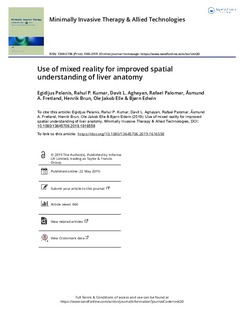| dc.contributor.author | Pelanis, Egidijus | |
| dc.contributor.author | Kumar, Rahul Prasanna | |
| dc.contributor.author | Aghayan, Davit | |
| dc.contributor.author | Palomar, Rafael | |
| dc.contributor.author | Fretland, Åsmund Avdem | |
| dc.contributor.author | Brun, Henrik | |
| dc.contributor.author | Elle, Ole Jacob | |
| dc.contributor.author | Edwin, Bjørn | |
| dc.date.accessioned | 2019-10-09T12:50:23Z | |
| dc.date.available | 2019-10-09T12:50:23Z | |
| dc.date.created | 2019-07-12T17:41:16Z | |
| dc.date.issued | 2019 | |
| dc.identifier.citation | MITAT. Minimally invasive therapy & allied technologies. 2019, 1-7. | nb_NO |
| dc.identifier.issn | 1364-5706 | |
| dc.identifier.uri | http://hdl.handle.net/11250/2621207 | |
| dc.description.abstract | Introduction: In liver surgery, medical images from pre-operative computed tomography and magnetic resonance imaging are the basis for the decision-making process. These images are used in surgery planning and guidance, especially for parenchyma-sparing hepatectomies. Though medical images are commonly visualized in two dimensions (2D), surgeons need to mentally reconstruct this information in three dimensions (3D) for a spatial understanding of the anatomy. The aim of this work is to investigate whether the use of a 3D model visualized in mixed reality with Microsoft HoloLens increases the spatial understanding of the liver, compared to the conventional way of using 2D images.
Material and methods: In this study, clinicians had to identify liver segments associated to lesions.
Results: Twenty-eight clinicians with varying medical experience were recruited for the study. From a total of 150 lesions, 89 were correctly assigned without significant difference between the modalities. The median time for correct identification was 23.5 [4–138] s using the magnetic resonance imaging images and 6.00 [1–35] s using HoloLens (p < 0.001).
Conclusions: The use of 3D liver models in mixed reality significantly decreases the time for tasks requiring a spatial understanding of the organ. This may significantly decrease operating time and improve use of resources. | nb_NO |
| dc.language.iso | eng | nb_NO |
| dc.publisher | Taylor & Francis | nb_NO |
| dc.rights | Attribution-NonCommercial-NoDerivatives 4.0 Internasjonal | * |
| dc.rights.uri | http://creativecommons.org/licenses/by-nc-nd/4.0/deed.no | * |
| dc.title | Use of mixed reality for improved spatial understanding of liver anatomy | nb_NO |
| dc.type | Journal article | nb_NO |
| dc.type | Peer reviewed | nb_NO |
| dc.description.version | publishedVersion | nb_NO |
| dc.source.pagenumber | 1-7 | nb_NO |
| dc.source.journal | MITAT. Minimally invasive therapy & allied technologies | nb_NO |
| dc.identifier.doi | 10.1080/13645706.2019.1616558 | |
| dc.identifier.cristin | 1711371 | |
| dc.description.localcode | © 2019 The Author(s). Published by Informa UK Limited, trading as Taylor & Francis Group. This is an Open Access article distributed under the terms of the Creative Commons Attribution-NonCommercial-NoDerivatives License (http://creativecommons.org/licenses/by-nc-nd/4.0/), which permits non-commercial re-use, distribution, and reproduction in any medium, provided the original work is properly cited, and is not altered, transformed, or built upon in any way. | nb_NO |
| cristin.unitcode | 194,63,10,0 | |
| cristin.unitname | Institutt for datateknologi og informatikk | |
| cristin.ispublished | true | |
| cristin.fulltext | original | |
| cristin.qualitycode | 1 | |

